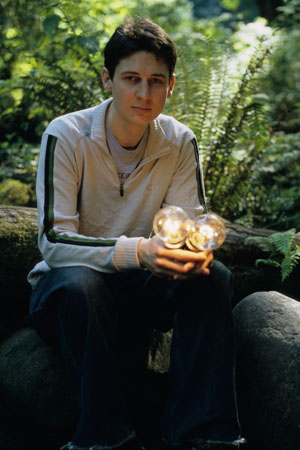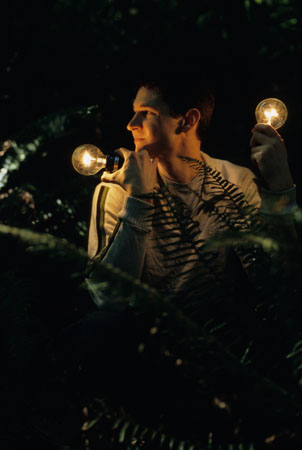
Sebastien Zimmerman is a local lighting designer who is based in Seattle USA. He has worked for such venues as The Showbox, Neumo’s and more. His light has been cast on acts like Modest Mouse, Band of Horses, Helio Sequence, Ice Cube, LCD Sound System and more.
In shooting Sebastien I was hoping to capture the essence of what it means to have the power of light in your hands. We shot outside under the shade of giant evergreens. It made for a really cool semidarkness that allowed patches of golden Sun to mingle with the globes Sebastien is holding. As our power supply started to run low is when we got some of the nicest shots. You can really see the filaments in each light. This shoot also made me think about what would ever happen if we couldn’t buy traditional lights?? If everything is compact fluorescent or LED then these kinds of images won’t be captured.
After the shoot we chatted and here is what followed...
Adam Forslund: When/how did you choose to focus on lighting design? It was 2002 I was helping this guy set up sound and light systems at nightclubs around Seattle and a few of the bigger rave events around town. I was still going to school for audio at the time and somehow worked my way in with him as an apprentice. I did as much as I could, learning and asking questions about anything I didn’t already know or understand. Every Friday and Saturday night he operated a night club with a sizable light package. There was already someone doing the lights and I basically peered over his shoulder for a long time. Finally I asked him if he could show me what all the “button pushing” was about. He walked me through the steps of writing and running a light show. We had fog, strobes, lasers, PAR’s and plenty of other cool things. I was hooked. Around this time during one of the dances we operated, I was pulled into the Showbox scene. Someone there saw what I was doing with the dance lighting and figured they could help me adapt my current skills with a heavier flavor geared towards main stream rock and roll. I (Again) apprenticed for another year learning new things like basic electricity, touring productions and conventional lighting. I spent a lot of time going to every show I could and helping out during load in and rehearsals. I guess when they felt I had learned enough, the guy split for tour and left me in charge of the day to day lighting operations for 9 months. When he came back, I had just finished cutting my teeth, hitting my stride and establishing myself as a reputable lighting designer. Then things fell into place. I kept getting calls to light shows, mostly from the Showbox, a few obscure events, but I kept myself open around town just to keep life fresh. Neumos took a liking to my work and they take a good deal of my time right now. I try to do things I’ve never done before to keep on the cutting edge and keep polished.
 AF: Why live in Seattle?
AF: Why live in Seattle?
SZ: I wasn’t born or raised here. I was born in California and did time in Denver and Austin before my family came to Seattle. When I moved out of my parent’s house there weren’t many options for relocation abroad. Since we grew up in the country I would try the city life as I had always had a calling for it. I moved downtown in late 2002 and have been here ever since. I’ve moved around inside the city several times and still haven’t found my ideal pad. Maybe I just have a hard time settling. Touring calls.
I choose to remain in Seattle because I’ve grown to love it. Well, it’s a love/hate relationship. Growing up partially in other areas of the country I can see both the good and bad this city has to offer. There are a lot of very educated people here, people who don’t hesitate to lend a hand to those in need, however, there is also a lot of passiveness, people not willing to stand up for themselves and who prefer to just go through the motions. I seem to have found my niche here in Seattle. I can see myself as sort of a shadow icon around town. People might not know exactly who I am or what it is I do, but they know I’m always around and am important. I like walking down the street some days and just catching the look of familiarity from people. Also, being close to my family is important to me. My younger brother lives just up north a ways, so it’s nice to see him from time to time. I’m not sure exactly how they’ll take my absence once I begin a life of touring, but I know they’ll trust I’m doing the right thing, and I’m doing what I love.
AF: Who are some of the bigger acts you have worked with?
SZ: I’ve had the pleasure of working with thousands of bands in the short time I’ve been involved in the industry, all of them with unique styles, levels of artistry and experience. I listened to some weird stuff growing up but my world musically has expanded so much since I’ve become actively involved with bands. I still have [Favorite Bands] I can’t wait to go out and pick up or see, but I’ve also learned to have a strong passion for music in its most pure and unbiased form. It’s one of the jobs great fulfillments, working with a variety in music every time you show up. As for the particulars, I’ve been a part of in full or partially responsible for lighting, Modest Mouse, Built To Spill, Band Of Horses, members of Pearl Jam, Ice Cube, Spiritualized, Helios Sequence, LCD Soundsystem, Melvins, Yelle, Ratatat, Sir Mix A Lot, CSS, Flava Flave, BRMC, The Wailers, Blue Scholars, M83, Dark Star Orchestra, etc. all. This list could go on for days, practically anything that tours through the city is usually something I’m a part of.
 AF: What was/is the most challenging aspect of your job on a day to day basis?
AF: What was/is the most challenging aspect of your job on a day to day basis?
SZ: There are challenges you find yourself up against for every show. Each day presents me with something unique. It’s rare that anything you did the previous day would carry over and be productive for the next. It’s this aspect that makes my job so enjoyable. At times we get technical riders which lay some of the ground work for what’s expected of everyone, but you usually find yourself throwing this out at the start of the day with a whole new set of rules. All the work needs to be done in order of operation, done safely, logically, artistically, and of course, time is the enemy. Some days are “easier” than others, and some can bite you in the ass. I find myself working with other designers, collaborating on artistic or technical challenges. Often times bands do not come equipped with this knowledge and it becomes my responsibility to ask questions, gather information and put together the best lighting design. The most challenging part of my job is tracking people down and trying to light acts I’ve never even heard or seen. At the end of the day, we put on a show and people leave with a smile.
AF: What would you like an audience member to take away from your work?
SZ: It doesn’t happen often, but when you feel it, that sense of togetherness, everything working. The artist and audience respond to each other while the lights and sound compliment the performance. People are drawn to what’s happening around them, and all at once everyone comes together to get into it. I would prefer to be taken away as a member of the audience yet I know that I am part of the audiences experience for the evening. It’s been said that the best work done is that which is performed without drawing attention to itself. When you put on your greatest show, people should be drawn to the artistic value behind your design and not for the technical whoopee it’s capable of doing. If I haven’t criticized myself all evening, nagging myself about the little things I could have done better, or the things I should have done differently, while I see everyone leaving with a smile on their face, that’s all I could ask for. I’m usually very accepting, and I’ll take the bad with the good, but great is always better.
Be sure to pay attention to the stage lighting next time you are watching your favorite band. If it's good Sebastien Zimmerman may have had a large part to do with that. We hope the best for him. AF
 Sebastien Zimmerman is a local lighting designer who is based in Seattle USA. He has worked for such venues as The Showbox, Neumo’s and more. His light has been cast on acts like Modest Mouse, Band of Horses, Helio Sequence, Ice Cube, LCD Sound System and more.
Sebastien Zimmerman is a local lighting designer who is based in Seattle USA. He has worked for such venues as The Showbox, Neumo’s and more. His light has been cast on acts like Modest Mouse, Band of Horses, Helio Sequence, Ice Cube, LCD Sound System and more.


 I have been doing more shooting with digital both in motion picture and still work.
I have been doing more shooting with digital both in motion picture and still work.